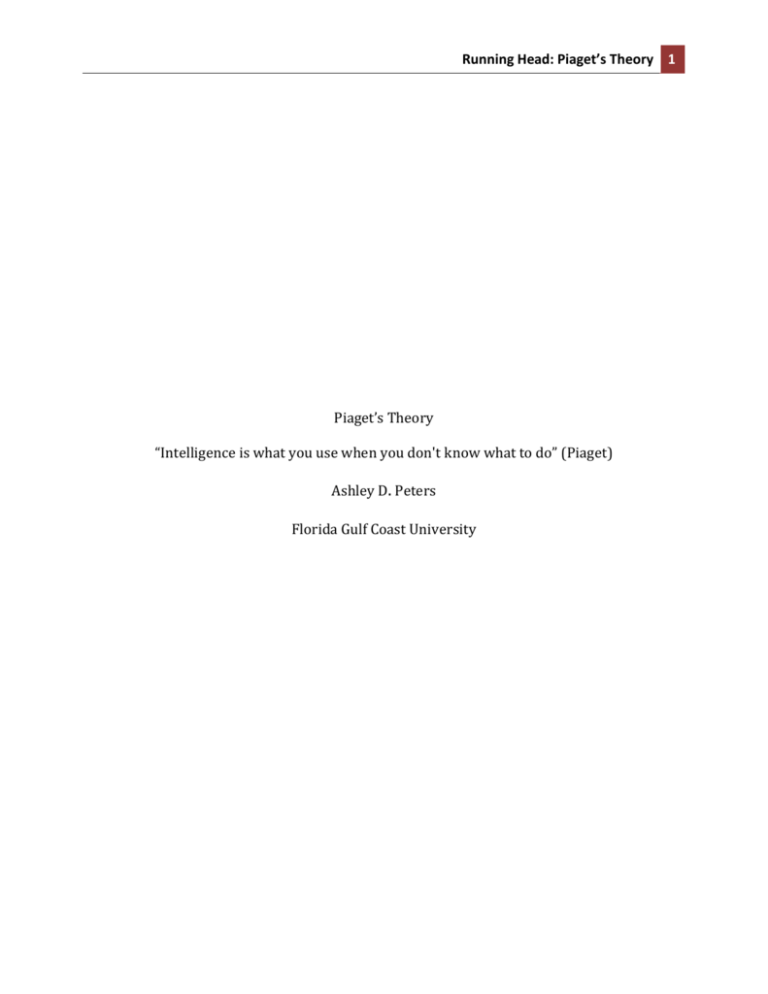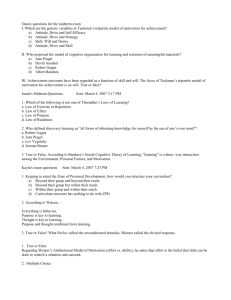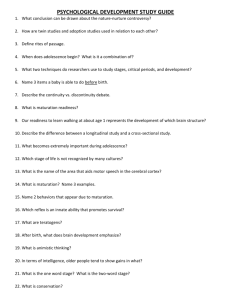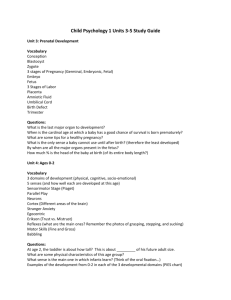Piaget___s_Theory
advertisement

Running Head: Piaget’s Theory 1 Piaget’s Theory “Intelligence is what you use when you don't know what to do” (Piaget) Ashley D. Peters Florida Gulf Coast University Running Head: Piaget’s Theory Jean Piaget was born in Neuchatel, Switzerland on August 9, 1896. His father was a professor at the University of Neuchatel. Piaget was a studious child and developed an interest in the natural sciences. At the age of eleven his notes on a rare part albino sparrow were published. That was just the first of many articles of his that would be published. He helped with classifying mollusks at the Natural History Museum in Neuchatel, which led to his interest in studying the shellfish. At the age of fifteen he had gained recognition by European zoologists for his publications on mollusks. He was forced to keep his young age a secret when submitting articles because many people felt he lacked credibility. (Notable Biographies, 2011). When he was 15 his articles led to a job offer at the history museum in Geneva, Switzerland. He studied zoology and philosophy at the University of Neuchatel and received his Doctorate in Zoology in 1918. (Notable Biographies, 2011). He later became interested in psychology and epistemology, which is the study of knowledge. He began working at two psychological labs in Zurich, Switzerland under the direction of Carl Jung and Eugene Bleuler who introduced him to psychoanalysis, which is the study of mental processes (Bio. True Story, 2010). He then moved to Paris and studied at the Sorbonne. After graduating he began teaching at Grange-Aux-Belles Street School with Alfred Binet who had created the Binet intelligence test. (Wikipedia, 2011). It was here that Piaget noticed that young children make mistakes on the test that older children and adults do not. (Wikipedia, 2011). This is what led to Piaget to develop the theory named after him. Running Head: Piaget’s Theory 3 Piaget’s theory states that there are four stages of development: Sensorimotor stage, Preoperational, Concrete operational, and Formal operational. The Sensorimotor stage is from birth to the age of two during which the child uses his/her five senses to discover the world. This stage is broken down in to six sub stages: Simple reflexes, first habits and primary circular reactions, secondary circular reactions, coordination of secondary circular reactions and tertiary circular reactions, novelty, and curiosity, and internalization of schemes. The second stage called Preoperational is from ages 2-7 years. Concrete operational stage is the third stage and occurs in ages 7-11 years. The fourth and final stage of Piaget’s theory is Formal operational stage and is ages 11-16 years old. Along with the stages Piaget also wanted to find a new way research methods were done. (Wikipedia, 2011). He worked on his theory throughout his lifetime, publishing many books and articles on his observations. Piaget married in 1923 to Valentine Chatenay and they had three children. Piaget studied his children from childbirth on and continued to work on his theory. (Wikipedia, 2011). Piaget received honorary degrees from many distinguished institutes such as Harvard, University of Brazil, Pennsylvania, Cambridge, and Yale just to name a few (Wikipedia, 2011). His influence is strongest on early education and moral education (Wikipedia, 2011). Jean Piaget died on September 17, 1980 at the age of 84. He has published hundreds of article and over fifty books. (Notable Biographies, 2011). Running Head: Piaget’s Theory Reference: Bio. True Story, (2010). Jean Piaget Biography. Encyclopedia britannica, inc. Retrieved August 30, 2011, from http://www.biography.com/articles/Jean-Piaget9439915?part=1 Notable Biographies, (2011). Jean Piaget Biography. Encyclopedia of world biography. Retrieved August 30, 2011, from http://www.notablebiographies.com/PePu/Piaget-Jean.html Wikipedia, Initials. (2011, August 29). Jean Piaget. Retrieved from http://en.wikipedia.org/wiki/Jean_Piaget





